#Streetcars
Explore tagged Tumblr posts
Text
So i'm working on a project that involves looking at people's opinions on public transportation, and something that keeps coming up is that a lot of people like the idea of public transportation but ridership is at the same time low, so I wanna figure out what stops people from riding.
If you could reblog this for bigger sample size that would be so so appreciated
#public transportation#city development#urban design#walkable cities#public transit#busses#trains#streetcars#metro#subway#poll#civic engagement#research#academia#opinions
7K notes
·
View notes
Text

New York circa 1900. "Grand Central Station, E. 42nd Street and Vanderbilt Avenue."
#vintage#turn of the century#New York City#streetcars#horse drawn carriage#1900s#street scene#trolley#NYC#horse and buggy#streetcar
60 notes
·
View notes
Text

The intersection of Nostrand and Putnam Avenues in Brooklyn in July 1931, where a streetcar that jumped the tracks rammed into a drug store.
Photo: NYC Municipal Archives via the NY Times
#vintage New York#1930s#vintage Brooklyn#streetcars#accident#streetcar accident#track jumping#vintage NYC
115 notes
·
View notes
Text

Street Car Named Desire, Todd Webb, New Orleans, 1948
49 notes
·
View notes
Text

Vintage Travel Poster - Fly TWA: San Francisco
Art by David Klein
Trans World Airlines (c.1960's)
#Posters#Travel#San Francisco#David Klein#TWA#Aviation#Fly TWA#Vintage#Art#Trans World Airlines#Russian Hill#Streetcars#Market Street#Chinese Dragons#1960s#60s
60 notes
·
View notes
Text

This lovely graphic shows the evolution of Atlanta's old streetcar system. It comes from a 2012 paper by Dawn Haynie at the GSU Urban Studies Institute.
Source:
Atlanta is a a city that was literally built around mass transit lines. Its original evolutionary path saw buildings organized in a format for walking to and from transit stops. I feel like a lot of folks aren’t aware of this.
People will say "Atlanta is a driving city" as if it's always been that way; as if the switch to car-centric placemaking wasn't an aberration in our history -- one we can absolutely change.
We can redesign Atlanta for inclusivity and sustainability by recognizing the mistake the city made by switching to a more car-centric type of urbanism.
We can grow in a better way, designing our new developments and our transportation system so that cars are de-centered and alternatives (transit, walking, cycling) are advanced.
That doesn't mean returning the city to exactly what it looked like in the 1920s. It means understanding that we veered off course from the evolutionary path we were on before we gave in to car-centric growth. We can connect back to that path and build a future that looks unique.
13 notes
·
View notes
Text
We would like to inform you all streetcars on route 4 will be short turning 3 stops before your stop. If you want to know the next streetcar that'll actually get you where you are going, ask the autistic trans girl who is also waiting for it, don't even bother asking staff.
9 notes
·
View notes
Text



Letter from Alexander T. Augusta to Assistant Secretary of War Charles A. Dana Regarding a Street Car Incident
Record Group 94: Records of the Adjutant General's OfficeSeries: Personal Papers of Medical Officers and PhysiciansFile Unit: Augusta, A.T., 1863-66
Washington, D. C., February 8th 1864. Hon. C. A. Dana, Assistant Secretary of War. Sir, I have the honor to report that your request of this date to forward to the Department an account of the outrage committed upon me by the Conductor of Car No. 32, of the City Railway Co., last week, has been received, and the following are the facts connected therewith:- I had been summoned at attend a Court Martial as a witness in the case of Private Geo: Taylor who was charged with causing the death of a colored man last August, the said colored man having died in the hospital of which I was at the time in Charge. I started from my lodging at the corner of 14th and I Streets, on the morning of February 1st for the purpose of proceeding to the hospital in order to obtain some notes relative to the case. As my time was short, and it was raining very hard at the time, I hailed the car which was passing just as I came out of the door, and it was stopped for me; but as I was in the act of entering, the conductor informed me that I would have to ride on the front of the driver. I told him I would not, and asked him why I could not ride inside. He stated that it was against the rules for colored persons to ride inside. I attempted to enter the car, and he pulled me out and ejected me from the platform. The consequence was I had to walk the whole distance through rain and mud, and was considerably detained past the hour for my attendance at Court. On my arrival, I reported the case to the Court. [full transcription at link]
14 notes
·
View notes
Note
Trains or trams
Trains, but also get out of here with your European bullshit it's called a Trolley/Streetcar
Anyway Interurbans are Both (and really a Streetcar is just a subset an order of trains)

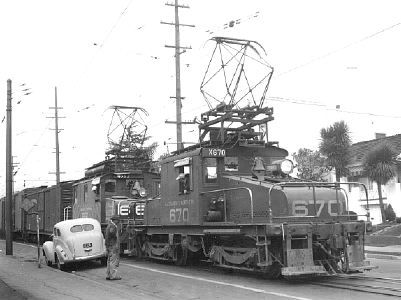
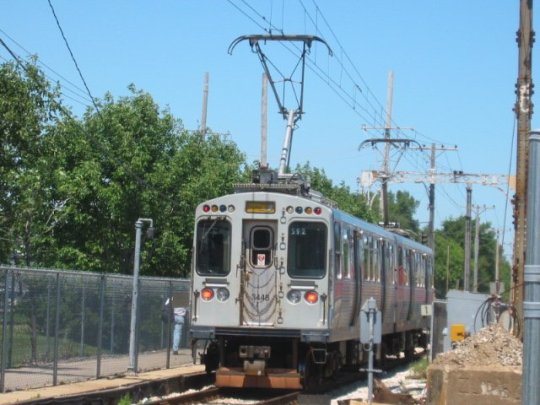

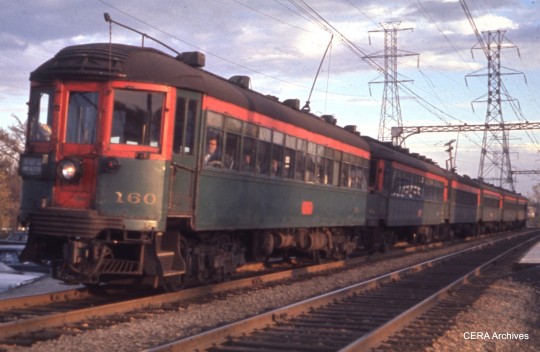
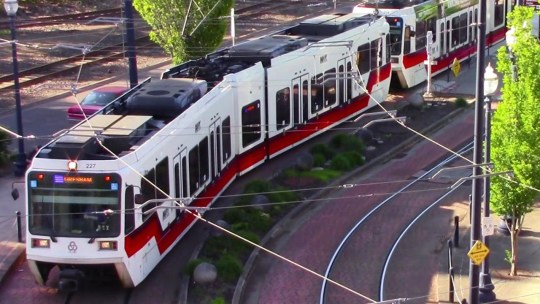




#trainposting#amtrak#electric traction#trolleyposting#interurban railroad#interurban#south shore railroad#north shore#chicago el#electrification#public transit#streetcars#streetcar#ttc streetcar#nj transit#septa#portland max#light rail
10 notes
·
View notes
Text
German street car lights
I researched this for my own reasons (that I may post about later), but I decided to put it here so I don't forget it.
Headlights. Taillights. We know how they work, we've all seen cars before. White in front, red in back, orange turn indicators, braking makes red extra bright. But for streetcars it's not always quite that simple, which makes modelling a challenge.
First of all, front: All cars and trucks and indeed all modern streetcars have two main headlights, side by side, roughly at the outer edges of the vehicle. Modern german streetcars actually have a third headlight up on top, legally required but barely visible. In this picture of a TW 6000 from Hanover (don't worry, the track curves away there, I was well clear of where the train could travel), it's the tiny little lamp above the destination display.
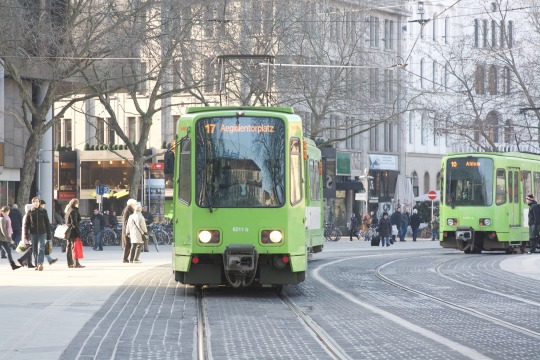
The idea is to make streetcars like big trains, which (in Germany, and for new trains in all of Europe) have three white lights in an upside-down V configuration in front (exceptions apply). The third light is supposed to make it clear that the thing hurtling towards you is a train. I'm not sure how well it works in this case.
But that is a fairly recent thing. For a really long time, well into the 1970s, the standard was a single central headlight. Consider this train in Vienna (note the pride flag, not relevant, just for fun):
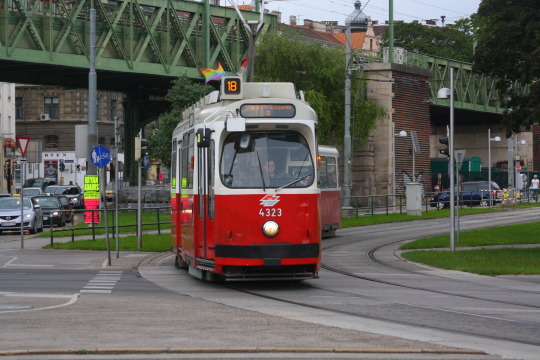
This is a type E₂ train, first introduced in 1978, still in use today (though probably not for much longer, if you're in Vienna and you see one of them, take a picture).
Now, Austria isn't Germany, but the standards between the two countries weren't that wildly different. As far as I can tell there was no one time when dual headlights were introduced; some cities bought trains with two headlights, some with one, often at the same time. The E₂ here was sold with single headlights to Vienna, Braunschweig, Augsburg, Duisburg and a couple of others, but also with dual headlights to Düsseldorf.
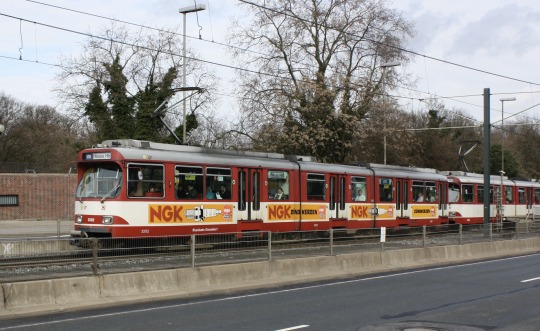
In fact, there was even a dual headlight version for Vienna, but specifically only for the Wiener Lokalbahnen, a sort of interurban railway that used streetcar tracks at the Vienna end of its route. This seems to have been a common division of headlights: Single for the purely city routes, double for the longer-distance ones, until everyone standardised on double, eventually with the third headlight on top.
For added confusion, some cities, most notably Stuttgart and Hanover, used double headlights stacked on top of each other. I assume that's meant to count as one headlight, just doubled up in case one burns out.
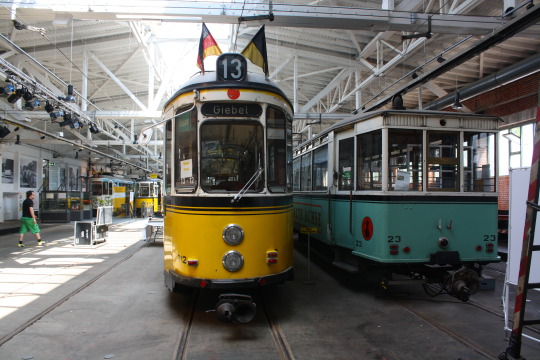
A very rare specialty: Two headlights side by side but mounted centrally, seen in Frankfurt am Main and I don't think a lot of other places. It's not relevant, I just want to show it because it looks so silly.
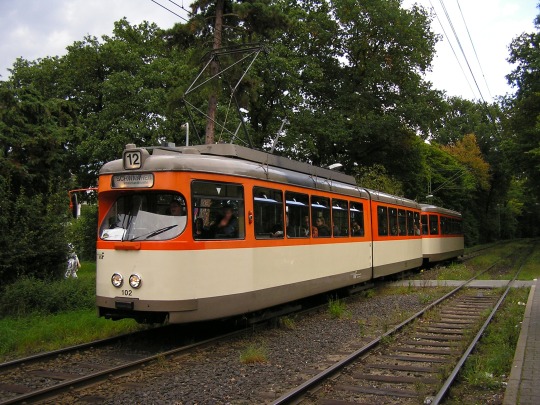
Picture: TdVG Harthweg M+m.jpg, © MdE on Wikimedia Commons and Wikipedia-DE, License: CC-BY-SA 3.0 DE
Next, turn indicators. All trams have turn indicators on their sides, generally at window level, but within the window level it's anyone's guess. Some place them near the roof, some more near the middle or bottom of the windows, it seems to be whatever the operator prefers. Turn indicators at the front, near the headlights, are surprisingly not that common. Most single-headlight trams don't have them, the turn indicators on the side have to be enough.
However, the turn indicators are often found at the rear of the train, and that also puts them on the front of dual-direction vehicles (which many trams aren't). See this Frankfurt trailing car, which can only run at the end of the train:
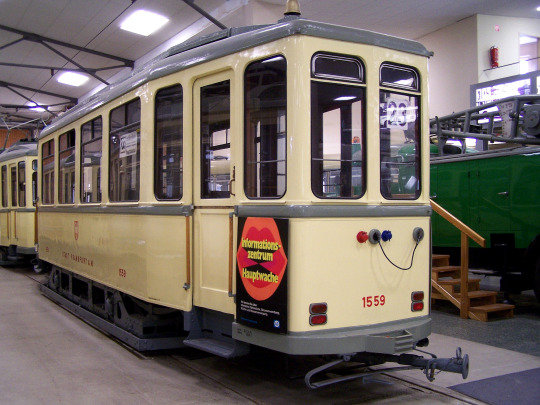
Picture: H-Beiwagen Schwanheim 01052009.JPG, © Urmelbeauftragter on Wikimedia Commons and Wikipedia-DE, License: CC-BY-SA 3.0 unported
You see two red tail lights, and two orange blinker lights. And, in fact, on a dual-direction train from Frankfurt, you'll see the same lights on the front:

Picture: Peter Stehlik 2012.02.18 015a.jpg, © Peter Stehlik on Wikimedia Commons and Wikipedia-DE, License: CC-BY-SA 3.0 unported
But this wasn't always the case. Consider the SSB B2 trailing car from Stuttgart. It has neither motor nor cab, and must always appear at the end of a train. Despite this, it has a (single) headlight for some reason. Perhaps for when the train needs to back up? Below it is a single red tail light. The two other red things near the coupler are just reflectors.
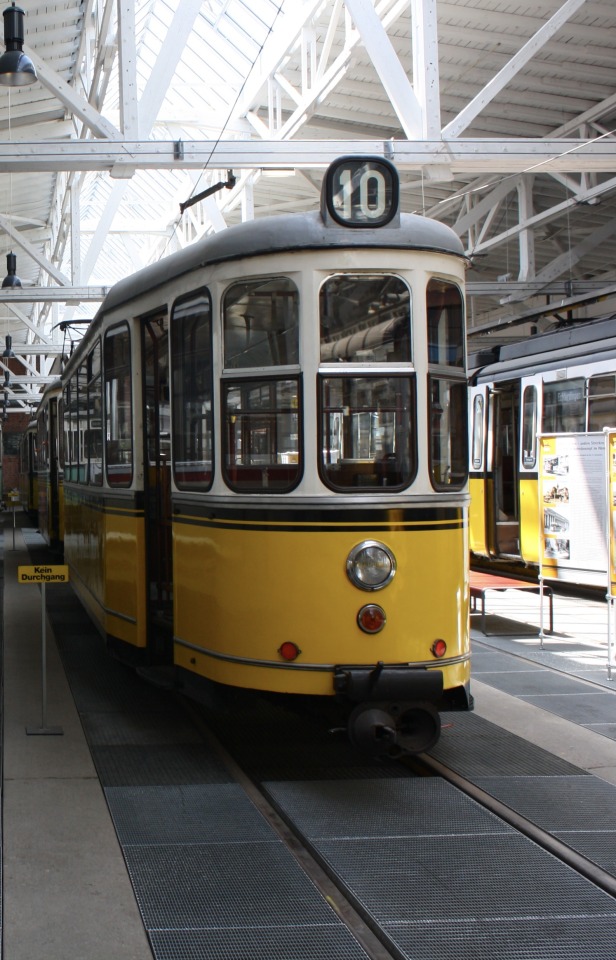
Actually, is that a red tail light? I took that picture in 2013, so it's been a while, and it looks pretty orange, both here and in some historic pictures, e.g. this one from 1979:
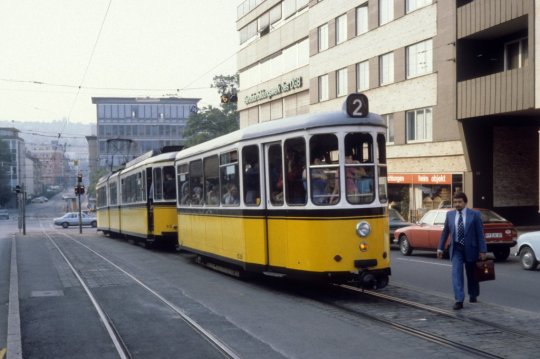
Picture: Stuttgart-ssb-sl-2-bw-654287.jpg, © Kurt Rasmussen from bahnbilder.de, found on Wikipedia, licensed for any use as long as the author is credited
Colors on old photographs are a bit of a crap shoot, and in newer videos the B2s definitely have red tail lights, like here:
youtube
But in that video it also doesn't have a headlight, so who knows what rebuilds that one in the video has been through.
Of course, if it's a single orange light, that raises the question: What's that for? Orange tail lights? As far as I can tell, probably not. In fact, a combination that is surprisingly not that uncommon is a single red and a single orange tail light, e.g. here on a historic tram in Nuremberg.
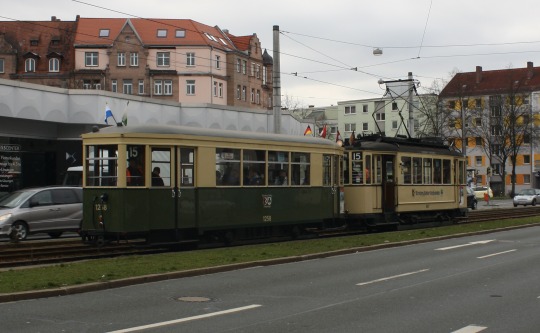
That yellow/orange light is not the "backwards turn indicator". It's the brake light.
Yes, orange brake lights used to be a thing in Germany. For cars, they were phased out in the 1960s. I think historic cars are still allowed to have them, if you can find one. For streetcars, they were phased out a bit later.
Specifically, 2016.
Until then it was legal and very common to have yellow brake lights on trams, even some very modern ones. These are usually combined with the rear turn indicators: If they both light up steadily, the tram is braking, if they're blinking, the tram is about to turn. According to Wikipedia, if it's braking and turning, then one light will light steadily, the other will be blinking, similar to those red turn signals some cars in the US use.
Note, however, that "make the red tail light brighter" (or "turn it on") seems to have been absolutely legal as well, just not super popular. This video from 1974, the final year of the streetcar system in Aachen shows both types of brake lights in action:
youtube
At this point the streetcar network in that city was in terminal decline, and all the cars there were either second-hand or cheaply rebuilt 1950s stuff, so it makes sense that the lighting system was all over the place.
Final note because it didn't fit anywhere else: A single giant tail light, at least on trailer cars, doesn't seem to have ever been used in Germany, but it was not uncommon in Austria.
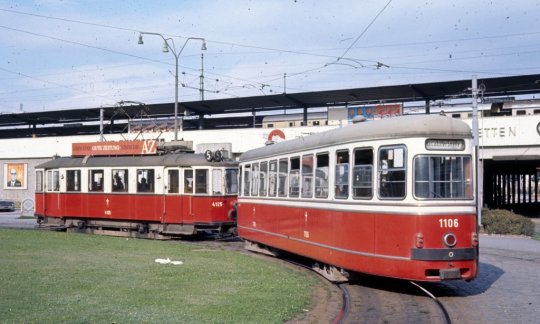
Picture: Wien-wvb-sl-5-c2-567109.jpg, © Kurt Rasmussen from bahnbilder.de, found on Wikipedia, licensed for any use as long as the author is credited
Other note: It seems that side turn indicators on trailer cars were optional at times. Weird.
So why do you need to know all of that? You don't. I never said you did. I did, however, because I'm currently modifying some trams for my model railroad with better lighting functions, and I wanted to know what the end result should be. The answer is, apparently, "do whatever you want", which is frankly very liberating.
I want to make it clear that this is not an expert or well researched piece. These are just the notes I made in my head while I was trying to figure this out. I almost certainly got things wrong, and I definitely missed some nuances. If you happen to know any, or can give more information on what it was like in your country, or you just feel like it, any comment/reblog with notes/anon hate is absolutely appreciated.
All pictures where no source is mentioned are © me. Use them under CC-BY-SA 3.0 if you want.
8 notes
·
View notes
Text
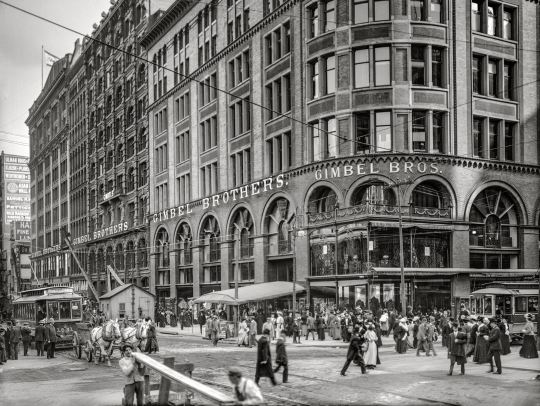
Philadelphia circa 1907. "Gimbel Brothers store, Market and Ninth streets."
#vintage#streetcars#1900s#downtown#street scene#trolley#horse drawn cart#streetcar#department store#turn of the century#Gimbels#street cars#pedestrians#Pennsylvania
224 notes
·
View notes
Text
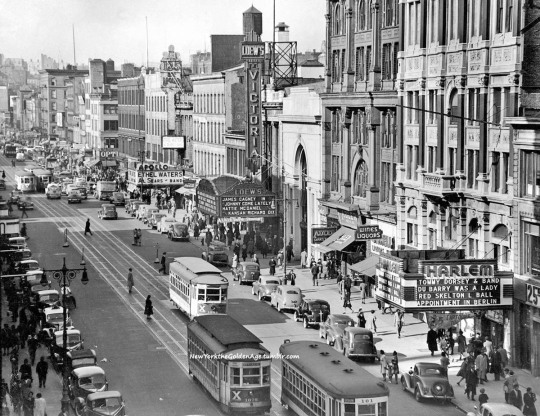
Streetcars run past the Apollo Theater, Loew's Victoria, and movie theaters on a busy afternoon on 125th Street in Harlem, 1944.
Photo: Herbert Gehr via Getty Images/BuzzFeed News
#vintage New York#1940s#Herbert Gehr#Harlem#vintage Harlem#125th St.#streetcars#street photography#street scene#urban life#vintage NYC#city life
117 notes
·
View notes
Text

"Bumblebee" historic streetcar, San Francisco
22 notes
·
View notes
Photo

Scenes from home, past and present.
21 notes
·
View notes
Text
Stop blaming Atlanta's streetcar for ridership failures and look instead at the urban design
There's a new, dimwitted rant against rail today from the libertarians at Reason. They argue that, because the current Atlanta streetcar is underused, any extension of it is bound to be useless.
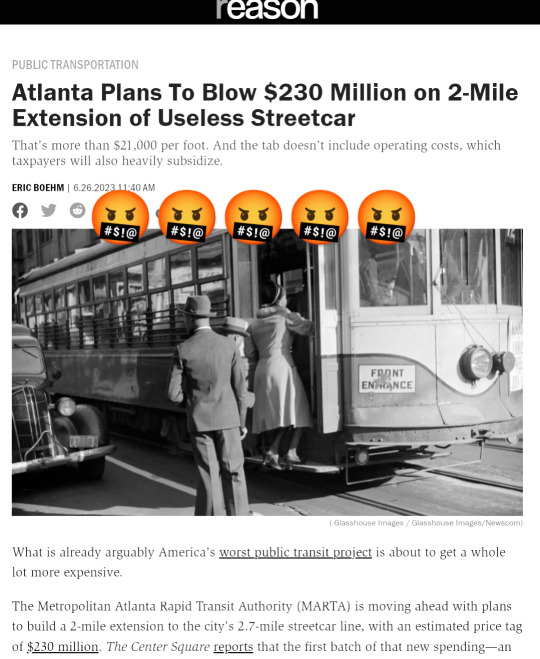
This argument is similar to the one where people see a useless bike lane that lasts only a few blocks and they say "look! No one's using it! We shouldn't build any more!"
Unfortunately, Atlanta's failure to improve the land-use around the current streetcar (or to give it priority over car traffic during big events) gives these anti-rail rants a level of credence that they don't deserve. It's a damn shame.
It's been 13 years since the federal government awarded Atlanta a $47 million grant for the current streetcar. The fact that much of the route is *still* abutted by empty buildings and parking facilities shows a gross misunderstanding of how land-use and transit should benefit each other.
And the fact that the streetcar gets regularly shut down during big events in Downtown, due to car traffic, is so ridiculous I often have trouble finding words.
In short, Atlanta isn't doing itself any favors when it comes to making a good case for street-rail expansion. These libertarian rants should be easier to rebut. We should have improved the urban design of Downtown to a level that helps street rail make great sense.
We still can, and should. Better late than never.
16 notes
·
View notes
Text
The terms “suburbs” and “suburbanization” often bring to mind the period after the Second World War, defined by rows of bungalows on tree-lined streets. Another image of the suburbs are the more recent stucco McMansions in far-flung areas of the city with garages standing guard over sidewalk-less streets.
In fact, the process of suburbanization emerged far earlier in Canadian cities and was deeply tied to the emergence of the streetcar as a revolutionary form of public transpiration.
Up until the late 19th century, there were no effective means of mass public transit and most people’s main form of transportation was walking. The lack of transit set real limitations in terms of where people could live. ...
The period saw Winnipeg as the main industrial and wholesale base for western Canada. With three railways crossing the city and the grain exchange being moved from Toronto to Winnipeg in 1890, Winnipeg was considered the “Chicago of the North.”
In 1910, Winnipeg accounted for 50 per cent of all manufacturing in western Canada. A massive industrial working class was created in Winnipeg, and those workers needed to get to work somehow.
Yearly streetcar paid fairs increased from 3.5 million passengers in 1900 to 60 million in 1913. The areas of the city that gained the most new residents in this time were west and south Winnipeg.
Streetcars were not only the most effective option for public transport but also used as a tool for land speculation that drove the creation of new developments and suburbs.
In many cases, streetcar lines were built into less-developed areas to spur on development and used as a promotional tool to attract homebuyers.
Land and subdivisions that had basic municipal services, paved sidewalks, sewers and piped water, were still the most desirable to homebuyers and developers – but by 1900, streetcar service was a requirement." - Scott Price, "The streetcar emerges," The Uniter. Volume 78, Number 06. October 19, 2023.
#winnipeg#streetcars#street railways#mass transit#public transportation#canadian history#land development#working class culture#suburbs
4 notes
·
View notes